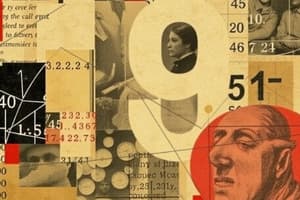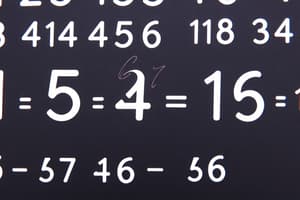Podcast
Questions and Answers
A store is selling pencils for $0.75 each and erasers for $0.50 each. Sarah buys 8 pencils and some erasers. If her total bill is $9.00, how many erasers did she buy?
A store is selling pencils for $0.75 each and erasers for $0.50 each. Sarah buys 8 pencils and some erasers. If her total bill is $9.00, how many erasers did she buy?
- 8
- 5
- 6
- 4 (correct)
The product of two negative integers is always negative.
The product of two negative integers is always negative.
False (B)
What is the value of $x$ in the equation: $3x + 7 = 22$?
What is the value of $x$ in the equation: $3x + 7 = 22$?
5
A triangle with all three sides of different lengths is called a ______ triangle.
A triangle with all three sides of different lengths is called a ______ triangle.
Match each geometric shape with its corresponding number of sides:
Match each geometric shape with its corresponding number of sides:
Flashcards
Grade 6 Mathematics
Grade 6 Mathematics
The study of mathematical concepts at the sixth-grade level, focusing on arithmetic, geometry, and basic algebra.
Revision Pack
Revision Pack
A collection of study materials and resources designed to help students review and reinforce their learning.
Term 1 Work
Term 1 Work
The curriculum topics and material covered in the first term of the academic year.
Diagrams in Maths
Diagrams in Maths
Signup and view all the flashcards
Study Purposes
Study Purposes
Signup and view all the flashcards
Study Notes
-
Number Systems:
- Understanding place value (ones, tens, hundreds, thousands etc.)
- Representing numbers in different forms (standard form, expanded form, word form).
- Ordering and comparing numbers.
- Rounding numbers to a given number of decimal places or significant figures.
- Recognising and using indices (powers). Examples of calculating 2^3, 5^2, or 10^4
- Identifying prime numbers and composite numbers.
- Finding the prime factorisation of a number. Example diagram for decomposing 12 into prime factors: (2 x 2 x 3)
- Basic operations with integers (addition, subtraction, multiplication and division).
-
Fractions, Decimals and Percentages:
- Understanding the relationship between fractions, decimals, and percentages (e.g., 1/2 = 0.5 = 50%).
- Converting between fractions, decimals, and percentages, including mixed numbers and improper fractions. Example diagram for converting 3/4 to a percentage
- Ordering and comparing fractions, decimals, and percentages efficiently.
- Addition, subtraction, multiplication, and division of fractions and decimals. Example: Calculate 1/2 + 3/4; 0.4 * 0.6.
- Simple percentage calculations (finding a percentage of a number, calculating percentage increase or decrease). Example: Calculate 20% of 150, or the price of an item, originally ₹40, after a 10% discount.
- Using fractions and decimals in real-world contexts (e.g., measurements, sharing, recipes). Example calculation: 3/5 of a pizza being eaten by one person.
Measurement:
- Units of length, mass, capacity, and time.
- Converting between different units within a system (e.g., meters to centimeters, kilograms to grams). Example diagram: a ruler showing cm, mm, and inches.
- Calculating perimeters, areas, and volumes of basic shapes: rectangles, squares, circles, cubes, and cuboids. Example diagrams for a rectangular prism indicating length, width, height, and calculation of volume.
- Using formulas for these calculations.
- Reading scales on measuring instruments.
- Calculating the area of composite shapes, potentially by partitioning.
- Understanding 2D and 3D shapes.
Algebra:
- Using variables and unknowns to represent quantities in mathematical statements.
- Writing expressions in algebra (e.g., 2x + 3).
- Evaluating expressions for given values of the variables.
- Solving simple equations using inverse operations (e.g., 2x = 6).
- Understanding and using inequalities (e.g., x > 5).
Ratio and Proportion:
- Understanding ratio as a comparison of two quantities. Diagram: Example representing 3:2 ratio and the proportional relationship
- Simplifying ratios.
- Understanding proportion as a similar relationship between two ratios.
- Solving problems involving direct proportion.
Geometry:
- Identifying different types of angles (acute, obtuse, right, straight, reflex). Example diagram illustrating different types of angles.
- Understanding properties of different 2D shapes (e.g., parallel sides, equal angles, symmetry).
- Understanding properties of different 3D shapes. Example diagram for different shapes like cubes, pyramids, rectangular prisms, and cones.
- Drawing 2D shapes and interpreting plans and elevations of 3D shapes.
Data Handling:
- Collecting, organising, and presenting data using appropriate methods (e.g., tables, bar charts, pictograms and line graphs). Example of a bar graph.
- Calculating mean, mode, median, and range of a set of data. Example problem set listing data, and asking for mean, median, mode, and range.
- Interpreting data from different representations and drawing conclusions.
Problem Solving:
- Applying the above concepts to solve word problems in everyday contexts.
- Breaking problems down into smaller, manageable steps.
- Identifying important information within the problem.
- Using different strategies to solve problems.
- Checking the reasonableness of solutions.
- Using mental calculations, written methods and calculators appropriately.
- Showing all workings clearly.
Studying That Suits You
Use AI to generate personalized quizzes and flashcards to suit your learning preferences.



